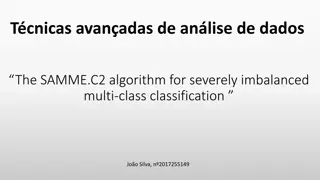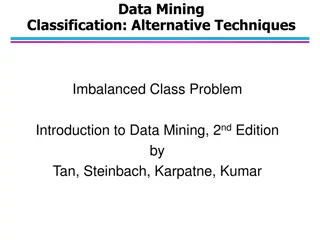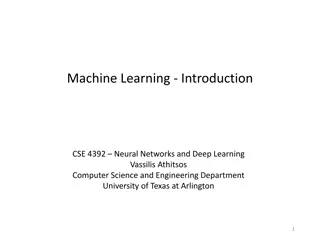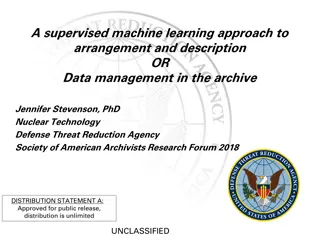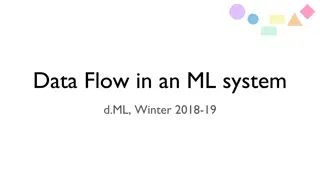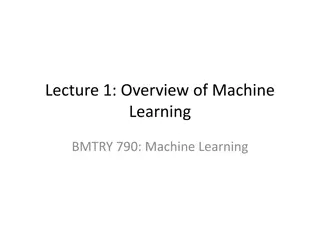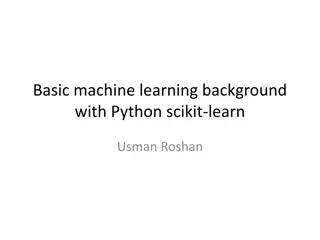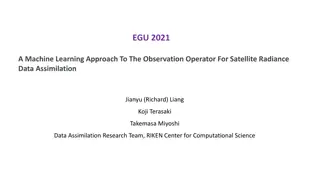Understanding Imbalanced Data in Machine Learning
Explore the challenges of imbalanced data in machine learning, illustrated through a scenario involving phishing email classification. Learn why classifiers tend to predict the majority class, strategies to address imbalance, and common domains with imbalanced data issues such as medical diagnosis and fraud detection.
Download Presentation

Please find below an Image/Link to download the presentation.
The content on the website is provided AS IS for your information and personal use only. It may not be sold, licensed, or shared on other websites without obtaining consent from the author. Download presentation by click this link. If you encounter any issues during the download, it is possible that the publisher has removed the file from their server.
E N D
Presentation Transcript
IMBALANCED DATA David Kauchak CS 158 Fall 2016
Admin Assignment 3: - how did it go? - do the experiments help? Assignment 4 Exam schedule
Setup for 1 hour, google collects 1M e-mails randomly they pay people to label them as phishing or not-phishing they give the data to you to learn to classify e-mails as phishing or not you, having taken ML, try out a few of your favorite classifiers you achieve an accuracy of 99.997% 1. 2. 3. 4. 5. Should you be happy?
Imbalanced data The phishing problem is what is called an imbalanced data problem 99.997% not-phishing There is a large discrepancy between the number of examples with each class label labeled data e.g. for 1M examples only ~30 would be phishing e-mails What is probably going on with our classifier? 0.003% phishing
Imbalanced data always predict not-phishing 99.997% accuracy Why does the classifier learn this?
Imbalanced data Many classifiers are designed to optimize error/accuracy This tends to bias performance towards the majority class Anytime there is an imbalance in the data this can happen It is particularly pronounced, though, when the imbalance is more pronounced
Imbalanced problem domains Besides phishing (and spam) what are some other imbalanced problems domains?
Imbalanced problem domains Medical diagnosis Predicting faults/failures (e.g. hard-drive failures, mechanical failures, etc.) Predicting rare events (e.g. earthquakes) Detecting fraud (credit card transactions, internet traffic)
Imbalanced data: current classifiers 99.997% not-phishing labeled data 0.003% phishing How will our current classifiers do on this problem?
Imbalanced data: current classifiers All will do fine if the data can be easily separated/distinguished Decision trees: explicitly minimizes training error when pruning/stopping early: pick majority label at leaves tend to do very poor at imbalanced problems k-NN: even for small k, majority class will tend to overwhelm the vote perceptron: can be reasonable since only updates when a mistake is made can take a long time to learn
Part of the problem: evaluation Accuracy is not the right measure of classifier performance in these domains Other ideas for evaluation measures?
identification tasks View the task as trying to find/identify positive examples (i.e. the rare events) Precision: proportion of test examples predicted as positive that are correct # correctly predicted as positive # examples predicted as positive Recall: proportion of test examples labeled as positive that are correct # correctly predicted as positive # positive examples in test set
identification tasks Precision: proportion of test examples predicted as positive that are correct # correctly predicted as positive # examples predicted as positive Recall: proportion of test examples labeled as positive that are correct # correctly predicted as positive # positive examples in test set correctly predicted positive precision predicted positive recall all positive
precision and recall data label predicted # correctly predicted as positive precision = # examples predicted as positive 0 0 0 1 # correctly predicted as positive recall = # positive examples in test set 1 0 1 1 0 1 1 1 0 0
precision and recall data label predicted # correctly predicted as positive precision = # examples predicted as positive 0 0 0 1 # correctly predicted as positive recall = # positive examples in test set 1 0 1 1 2 0 1 precision = 4 1 1 2 recall = 3 0 0
precision and recall data label predicted # correctly predicted as positive precision = # examples predicted as positive 0 0 0 1 # correctly predicted as positive recall = # positive examples in test set 1 0 1 1 0 1 Why do we have both measures? How can we maximize precision? How can we maximize recall? 1 1 0 0
Maximizing precision data label predicted # correctly predicted as positive precision = # examples predicted as positive 0 0 0 0 # correctly predicted as positive recall = # positive examples in test set 1 0 1 0 0 0 Don t predict anything as positive! 1 0 0 0
Maximizing recall data label predicted # correctly predicted as positive precision = # examples predicted as positive 0 1 0 1 # correctly predicted as positive recall = # positive examples in test set 1 1 1 1 0 1 Predict everything as positive! 1 1 0 1
precision vs. recall Often there is a tradeoff between precision and recall increasing one, tends to decrease the other For our algorithms, how might we increase/decrease precision/recall?
precision/recall tradeoff data label predicted confidence - For many classifiers we can get some notion of the prediction confidence 0 0 0.75 0 1 0.60 1 0 0.20 - Only predict positive if the confidence is above a given threshold 1 1 0.80 0 1 0.50 - By varying this threshold, we can vary precision and recall 1 1 0.55 0 0 0.90
precision/recall tradeoff data label predicted confidence put most confident positive predictions at top 1 1 0.80 0 1 0.60 put most confident negative predictions at bottom 1 1 0.55 calculate precision/recall at each break point/threshold 0 1 0.50 1 0 0.20 classify everything above threshold as positive and everything else negative 0 0 0.75 0 0 0.90
precision/recall tradeoff data label predicted confidence precision recall 1/1 = 1.0 1/3 = 0.33 1 1 0.80 0 1 0.60 1 1 0.55 0 1 0.50 1 0 0.20 0 0 0.75 0 0 0.90
precision/recall tradeoff data label predicted confidence precision recall 1 1 0.80 0 1 0.60 1/2 = 0.5 1/3 = 0.33 1 1 0.55 0 1 0.50 1 0 0.20 0 0 0.75 0 0 0.90
precision/recall tradeoff data label predicted confidence precision recall 1 1 0.80 0 1 0.60 2/3 = 0.67 2/3 = 0.67 1 1 0.55 0 1 0.50 1 0 0.20 0 0 0.75 0 0 0.90
precision/recall tradeoff data label predicted confidence precision recall 1.0 0.33 1 1 0.80 0 1 0.60 0.5 0.33 1 1 0.55 0.66 0.66 0 1 0.50 0.5 0.66 1 0 0.20 0.5 1.0 0 0 0.75 0.5 1.0 0 0 0.90 0.5 1.0
precision-recall curve 1.0 0.8 Precision 0.6 0.4 0.2 0.0 0.0 0.2 0.4 0.6 0.8 1.0 Recall
Which is system is better? precision precision recall recall How can we quantify this?
Area under the curve Area under the curve (PR-AUC) is one metric that encapsulates both precision and recall calculate the precision/recall values for all thresholding of the test set (like we did before) then calculate the area under the curve can also be calculated as the average precision for all the recall points (and many other similar approximations)
Area under the curve? precision precision recall recall Any concerns/problems?
Area under the curve? precision precision ? recall recall For real use, often only interested in performance in a particular range Eventually, need to deploy. How do we decide what threshold to use?
Area under the curve? precision precision ? recall recall Ideas? We d like a compromise between precision and recall
A combined measure: F Combined measure that assesses precision/recall tradeoff is F measure (weighted harmonic mean): + 2 1 ( ) 1 PR = = F 1 1 + 2 P R + 1 ( ) P R where (or ) is a parameter that trades biases more towards precision or recall 1 a = 1+b2
F1-measure Most common =0.5: equal balance/weighting between precision and recall: 1 + 2 ( ) 1 PR = = F 1 1 + 2 P R + 1 ( ) P R 1 =2PR P+R F1= 0.51 P+0.51 R
A combined measure: F Combined measure that assesses precision/recall tradeoff is F measure (weighted harmonic mean): + 2 1 ( ) 1 PR = = F 1 1 + 2 P R + 1 ( ) P R Why harmonic mean? Why not normal mean (i.e. average)?
F1 and other averages Combined Measures 100 80 Minimum Maximum Arithmetic Geometric Harmonic 60 40 20 0 0 20 40 60 80 100 Precision (Recall fixed at 70%) Harmonic mean encourages precision/recall values that are similar!
Evaluation summarized Accuracy is often NOT an appropriate evaluation metric for imbalanced data problems precision/recall capture different characteristics of our classifier PR-AUC and F1 can be used as a single metric to compare algorithm variations (and to tune hyperparameters)
Training classifiers? precision/recall capture different characteristics of our classifier PR-AUC and F1 can be used as a single metric to compare algorithm variations (and to tune hyperparameters) Can we train our classifiers to maximize this (instead of accuracy/error)?
Black box approach Abstraction: we have a generic binary classifier, how can we use it to solve our new problem +1 optionally: also output a confidence/score binary classifier -1 Can we do some pre-processing/post-processing of our data to allow us to still use our binary classifiers?
Idea 1: subsampling Create a new training dataset by: - including all k positive examples - randomly picking k negative examples 99.997% not-phishing labeled data 50% not-phishing 50% phishing pros/cons? 0.003% phishing
Subsampling Pros: Easy to implement Training becomes much more efficient (smaller training set) For some domains, can work very well Cons: Throwing away a lotof data/information
Idea 2: oversampling Create a new training data set by: - include all m negative examples - include m positive examples: - repeat each example a fixed number of times, or - sample with replacement 99.997% not-phishing labeled data 50% not-phishing 50% phishing 0.003% phishing pros/cons?
oversampling Pros: Easy to implement Utilizes all of the training data Tends to perform well in a broader set of circumstances than subsampling Cons: Computationally expensive to train classifier
Idea 2b: weighted examples cost/weights Add costs/weights to the training set 99.997% not-phishing negative examples get weight 1 labeled data 1 positive examples get a much larger weight change learning algorithm to optimize weighted training error 99.997/0.003 = 33332 0.003% phishing pros/cons?
weighted examples Pros: Achieves the effect of oversampling without the computational cost Utilizes all of the training data Tends to perform well in a broader set circumstances Cons: Requires a classifier that can deal with weights Of our three classifiers, can all be modified to handle weights?
Building decision trees with weights Otherwise: - calculate the score for each feature if we used it to split the data - pick the feature with the highest score, partition the data based on that data value and call recursively We used the training error to decide on which feature to choose: use the weighted training error In general, any time we do a count, use the weighted count (e.g. in calculating the majority label at a leaf)
Idea 3: optimize a different error metric Train classifiers that try and optimize F1 measure or AUC or or, come up with another learning algorithm designed specifically for imbalanced problems pros/cons?
Idea 3: optimize a different error metric Train classifiers that try and optimize F1 measure or AUC or Challenge: not all classifiers are amenable to this or, come up with another learning algorithm designed specifically for imbalanced problems Don t want to reinvent the wheel! That said, there are a number of approaches that have been developed to specifically handle imbalanced problems


